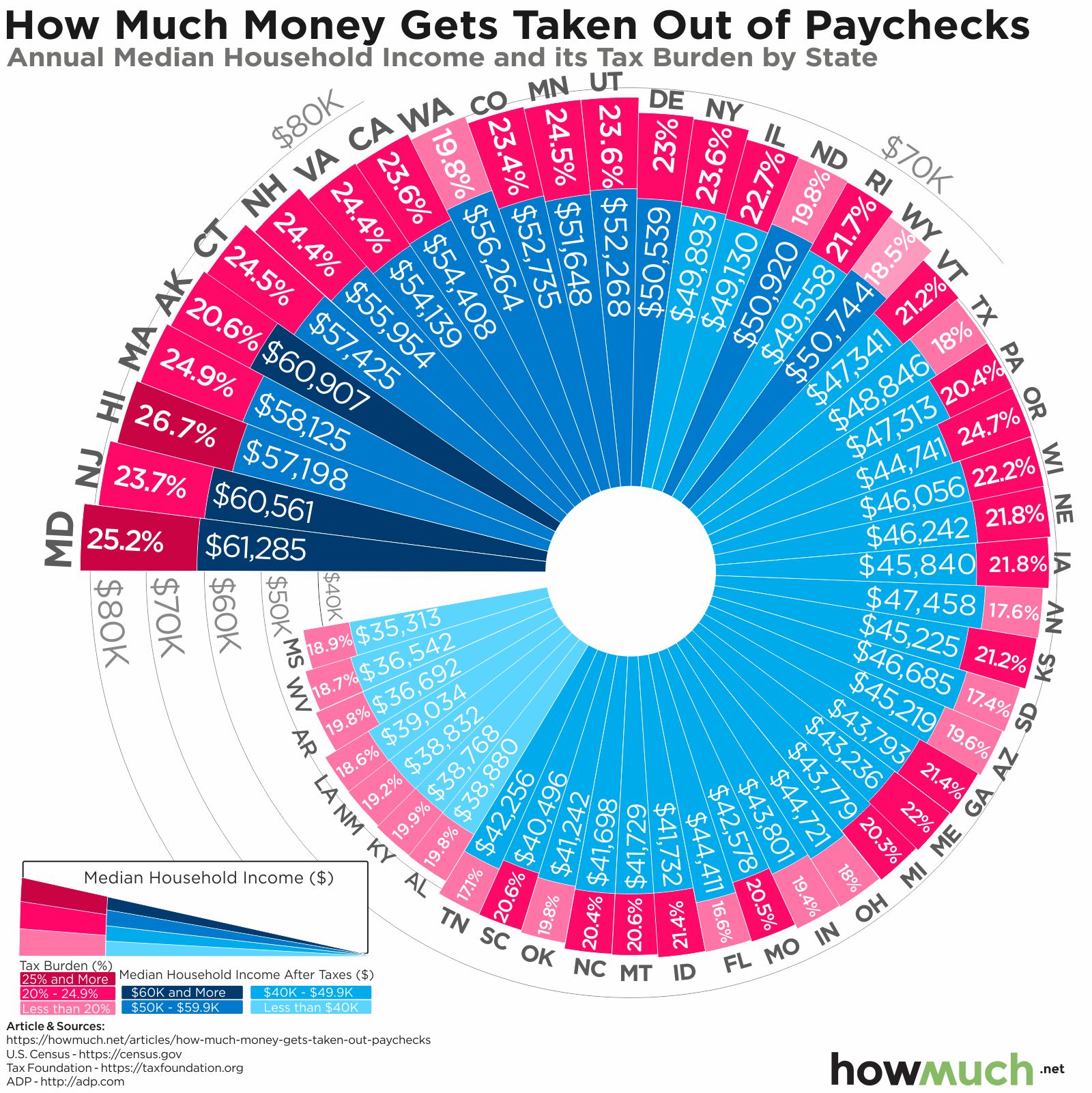The coronavirus has forced the U.S. economy to ground to a halt. The IRA extended the deadline to file taxes, and with the vast majority of the country under a stay-at-home order, more than 16 million people filed for unemployment over the last 3 weeks. Like other social programs, unemployment benefits are funded by taking a percentage out of workers’ paychecks. But the relative tax burden for U.S. workers depends on the state, as our latest visualization makes clear.

- Hawaiians pay the heaviest tax burden in the country, contributing 26.7% of their income to taxes, leaving $57,198 for workers to take home.
- Floridians enjoy the lowest tax burden, paying just 16.6% of total income. This leaves $44,411 in median annual take home pay.
- 29 states have tax burdens between 20% to 25% of annual income, leaving between $40,000 to $50,000 of income.
- States with no income tax don’t always have the lightest tax burden, suggesting that governments look for other ways to generate just as much revenue.
We found the data for our visualization at GOBankingRates. First, we ranked each state based on the size of the median annual household income, according to the 2018 American Community Survey from the U.S. Census. Then, we used the total tax burden individual filers pay each year using the standard deduction, expressed as a percentage of total income (pink and red). We used 2020 federal and state tax brackets according to the Tax Foundation, including FICA taxes. Finally, we calculated how much money is left for take-home pay (blue). The result is an intuitive demonstration of how tax burdens vary around the country.
Top 5 States with the Lowest Tax Burden
1. Florida: 16.6% on median income of $53,267
2. Tennessee: 17.1% on median income of $50,972
3. South Dakota: 17.4% on median income of $56,499
4. Nevada: 17.6% on median income of $57,598
5. Ohio: 18% on median income of $54,533
Top 5 States with the Highest Tax Burden
1. Hawaii: 26.7% on median income of $78,084
2. Maryland: 25.2% on median income of $81,868
3. Massachusetts: 24.9% on median income of $77,378
4. Oregon: 24.7% on median income of $59,393
5. Connecticut: 24.6% on median income of $76,106
One insight from our visualization is how low-income states generally see lower tax burdens. Mississippi, West Virginia and Arkansas are among the poorest states in the country, and consequently residents in each state pay less than 20% in total taxes. On the other hand, high-income states typically pay a greater percentage of their income in taxes. Maryland and Hawaii are among the top 3 highest income states, and they both pay over 25% in taxes. That’s because progressive tax systems require high-income earners to pay more, expressed as a percentage of income, than low-income earners. Of course, how much individual states are getting back from the federal government is also unequal.
But that’s just at the federal level. Alaska, Nevada, Texas, Wyoming, New Hampshire, Florida, South Dakota, Washington and Tennessee all don’t have a statewide income tax. What’s the tax burden look like in those places? Unsurprising, taxpayers in these states usually get to keep a higher percentage of their income. Washington deserves special mention with a tax burden of only 19.8% leaving take home pay of $56,264. Several other income tax-free states likewise place tax burdens on workers of less than 20%, including Wyoming (18.5%), Texas (18%) and Nevada (17.6%). But that’s not always the case. New Hampshire stands out with a tax burden of 24.4%, meaning taxpayers are no doubt seeing bigger fees and excise taxes to make up for the lost revenue.
What’s your impression of the relative size of the tax burden where you live? Do you think you are getting a fair bargain for your money, or not? Let us know in the comments.
Do you need insurance for your business? Don't worry, we've got you covered.
Check Our Business Insurance Guides
General Liability Insurance Cost
Errors & Omissions Insurance Cost
Legal Malpractice Insurance Cost
Business Insurance Cost for Startups
Medical Malpractice Insurance Cost
Commercial Property Insurance Cost
Product Liability Insurance Cost
Data: Table 1.1
About the article
Authors
Irena - Editor





